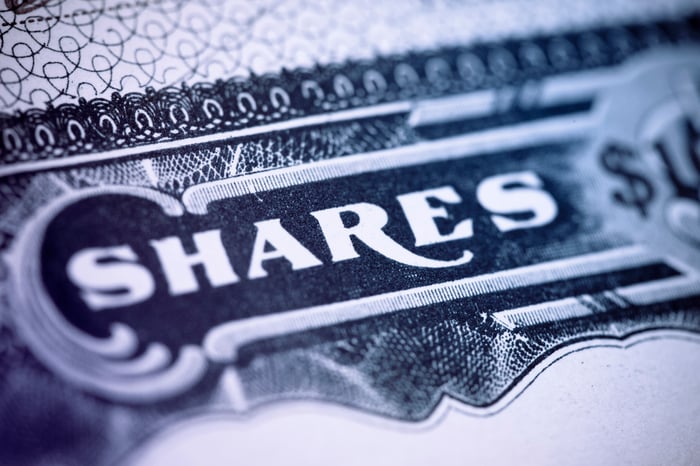Volatility has been readily apparent on Wall Street for more than three years. Investors have been taken for quite the ride, which has included two bear markets (2020 and 2022), as well as a period where the stock market appeared virtually unstoppable (2021).
When equities get whipsawed, professional and everyday investors often turn to companies that have a history of outperforming. Over the past two years, companies enacting stock splits fit the bill perfectly.
A "stock split" is an event which allows a publicly traded company to change both its share price and outstanding share count while having no effect on its market cap or operating performance. This purely cosmetic change can make a company's shares more nominally affordable for investors who lack access to fractional-share purchases, or can lift a company's share price to ensure it meets the minimum requirements for continued listing on a major exchange.

Image source: Getty Images.
Most investors tend to gravitate to forward-stock splits, which are the type that reduce a company's share price while increasing its share count by the same factor. Companies enacting forward splits are usually highfliers with phenomenal long-term growth prospects. Since the start of July 2021, eight high-profile stocks have enacted forward splits, with a ninth on the way later this week (listed in chronological order by date of split):
- Nvidia (NVDA 6.18%): 4-for-1 split in July 2021
- Amazon (AMZN 3.43%): 20-for-1 split in June 2022
- DexCom (DXCM -9.90%): 4-for-1 split in June 2022
- Shopify (SHOP 1.11%): 10-for-1 split in June 2022
- Alphabet (GOOG 9.96%) (GOOGL 10.22%): 20-for-1 split in July 2022
- Tesla (TSLA -1.11%): 3-for-1 split in August 2022
- Palo Alto Networks (PANW 0.91%): 3-for-1 split in September 2022
- Monster Beverage (MNST 0.41%): 2-for-1 split in March 2023
- Novo Nordisk (NVO 0.84%): 2-for-1 split to be effective on Sept. 20, 2023
The outperformance of these nine stock-split stocks isn't lost on Wall Street's billionaire investors. Based on the latest round of Form 13F filings, billionaires couldn't stop buying three stock-split stocks.
Stock-split stock No. 1 billionaires can't stop buying: Nvidia
Despite its share price shooting to the heavens since the year began, billionaire money managers have had no hesitation piling into semiconductor solutions specialist Nvidia. The June-ended quarter saw 11 billionaire fund managers buy into the Nvidia growth story or add to their existing positions, including (total shares purchased in the second quarter in parenthesis):
- Jeff Yass of Susquehanna International (5,401,204 shares)
- Jim Simons of Renaissance Technologies (1,852,712 shares)
- Israel Englander of Millennium Management (1,023,518 shares)
- David Tepper of Appaloosa Management (870,000 shares)
- Steven Cohen of Point72 Asset Management (662,385 shares)
- Stephen Mandel of Lone Pine Capital (641,649 shares)
- David Siegel and John Overdeck of Two Sigma Investments (629,072 shares)
- Chase Coleman of Tiger Global Management (584,700 shares)
- Dan Loeb of Third Point (500,000 shares)
- Ole Andreas Halvorsen of Viking Global Investors (312,400 shares)
The impetus behind this overwhelming conviction is the rise of artificial intelligence (AI). AI involves using software and systems to cover tasks normally assigned to humans. With machine learning, AI solutions have the ability to learn, evolve, and become more efficient at their tasks over time.
Nvidia is effectively powering the AI revolution. Its high-powered graphics processing units (GPUs) are being used in a majority of AI-accelerated data centers. Nvidia's A100 and H100 GPUs are believed to account for around 90% of high-compute GPUs in enterprise data centers.
The thing is, Nvidia is just getting started. Production of the A100 and H100 have been constrained by chip on wafer on substrate (CoWos) capacity at chip fabrication giant Taiwan Semiconductor Manufacturing Company, which is commonly known as "TSMC." With TSMC doubling its CoWoS capacity, Nvidia should be able to vastly increase its output of A100 and H100 GPUs in 2024, and likely well beyond.
What remains to be seen is if Nvidia can hold its monstrous year-to-date gains. Competition is set to pick up in a big way from the likes of Advanced Micro Devices and Intel over the next two years.
Additionally, increasing output is expected to be detrimental to Nvidia's pricing power. As scarcity is removed and businesses reassess their AI needs, Nvidia could see its calendar year 2024 gross margin come under serious pressure.
Stock-split stock No. 2 billionaires can't stop buying: Novo Nordisk
A second stock-split stock that Wall Street's billionaire investors simply can't get enough of is pharmaceutical giant Novo Nordisk, which is splitting its shares this coming Wednesday. Four prominent billionaire fund managers mashed the buy button on Novo Nordisk during the second quarter (total shares purchased in the second quarter in parenthesis):
- Chase Coleman at Tiger Global Management (634,500 shares)
- David Siegel and John Overdeck at Two Sigma Investments (301,341 shares)
- Israel Englander at Millennium Management (95,273 shares)
The catalyst behind this optimism from billionaires primarily has to do with Novo Nordisk's injectable glucagon-like peptide-1 (GLP-1) drugs Ozempic, Saxenda, and Wegovy. The former is used to treat type 2 diabetes, with the latter two are approved by the U.S. Food and Drug Administration for chronic weight management. Ozempic is Novo Nordisk's shining star, with sales totaling nearly $6 billion in the first-half of 2023, up 58% from the prior-year period.
GPL-1 therapies are a potential game-changer for those seeking/needing to lose weight. GLP-1 receptor agonists cause the stomach to empty more slowly, as well as signal to the brain that there's still food in the stomach, which collectively leads to less desire to eat. Considering that close to 42% of American adults were estimated to be obese in 2017, per the Centers for Disease Control and Prevention, a potentially massive opportunity awaits Novo Nordisk.
However, it won't be walk in the park for Novo Nordisk, even if it does have a head start with its lineup of GLP-1 receptor agonists. New competition is on the horizon that could eventually give Ozempic a run for its money.
Likewise, Novo Nordisk is being priced for perfection. After 25 years of investing on Wall Street and studying drug developers, I can assure you that virtually nothing ever goes according to plan.

Image source: Getty Images.
Stock-split stock No. 3 billionaires can't stop buying: Shopify
The third stock-split stock that billionaires seemingly can't stop buying is cloud-based e-commerce platform Shopify. The June-ended quarter saw five billionaires pile into Shopify stock, including (total shares purchased in the second quarter in parenthesis):
- Ken Griffin of Citadel Advisors (1,704,417 shares)
- Steven Cohen of Point72 Asset Management (1,510,804 shares)
- David Siegel and John Overdeck of Two Sigma Investments (872,211 shares)
- Israel Englander of Millennium Management (605,022 shares)
The fuel behind billionaires' interest in Shopify looks to be a combination of better-than-expected economic data, as well as better-than-anticipated growth for the company.
With regard to the former, we've witnessed the Federal Reserve remove prior forecasts of a U.S. recession, and have seen the U.S. unemployment rate remain steadily below 4%. Since the retail industry is highly cyclical, an improving macroeconomic outlook bodes well for retailers and the company (Shopify) they're using to create and manage their online retail presence.
As for Shopify, it's used the power of its platform to pass along hefty price hikes to its monthly and annual subscribers. As my Foolish colleague Danny Vena laid out in January, monthly subscription prices rose by 33% or 34%, while annual subscription costs nearly doubled for those who took advantage of a 50%-off promotion for their first year of service. Having the ability to raise prices by this magnitude has solidified Shopify's strong double-digit growth rate.
However, it's worth pointing out that U.S. real retail sales -- retail sales growth less the rate of inflation -- has been negative on a year-over-year basis in each of the past 10 months. While Shopify's price hikes are hitting home, consumer sentiment is still shaky, at best.
Similar to Nvidia and Novo Nordisk, Shopify is also aggressively priced for growth. But with forecast earnings in 2023 that would place its price-to-earnings ratio in the triple-digits, it's fair to question if the company's sizable year-to-date gain can hold up under potential macro pressures.





